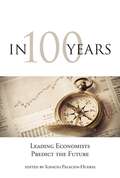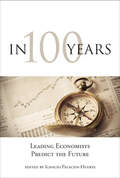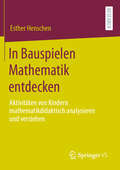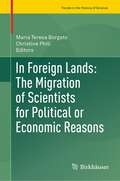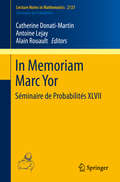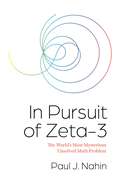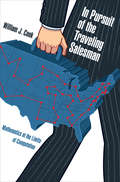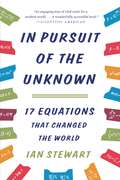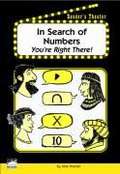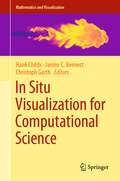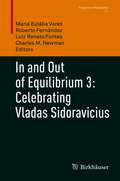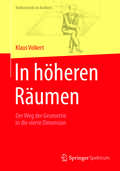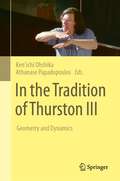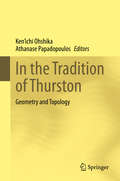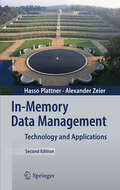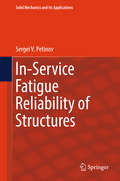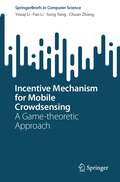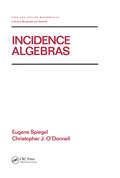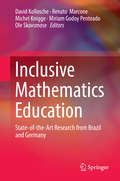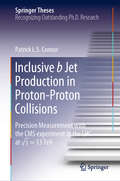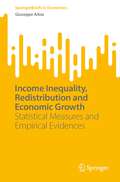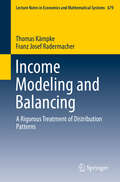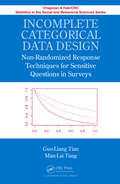- Table View
- List View
In 100 Years
by Ignacio Palacios-HuertaThis pithy and engaging volume shows that economists may be better equipped to predict the future than science fiction writers. Economists' ideas, based on both theory and practice, reflect their knowledge of the laws of human interactions as well as years of experimentation and reflection. Although perhaps not as screenplay-ready as a work of fiction, these economists' predictions are ready for their close-ups. In this book, ten prominent economists -- including Nobel laureates and several likely laureates -- offer their ideas about the world of the twenty-second century. In scenarios that range from the optimistic to the guardedly gloomy, these thinkers consider such topics as the transformation of work and wages, the continuing increase in inequality, the economic rise of China and India, the endlessly repeating cycle of crisis and (projected) recovery, the benefits of technology, the economic consequences of political extremism, and the long-range effects of climate change. For example, Daron Acemoglu offers a thoughtful discussion of how trends of the last century -- including uneven growth, technological integration, and resource scarcity -- might translate into the next; 2013 Nobelist Robert Shiller provides an innovative view of future risk management methods using information technology; 2012 Nobelist Alvin Roth projects his theory of Matching Markets into the next century, focusing on schools, jobs, marriage and family, and medicine; 1987 Nobelist Robert Solow considers the shift away from remunerated labor, among other subjects; and Martin Weitzman raises the intriguing but alarming possibility of using geoengineering techniques to mitigate the nevitable effects of climate change. In a 1930 essay mentioned by several contributors, "Economic Possibilities for Our Grandchildren," John Maynard Keynes offered predictions that, read today, range from absolutely correct to spectacularly wrong. This book follows in Keynes's path, hoping, perhaps, to better his average.
In 100 Years: Leading Economists Predict the Future (The\mit Press Ser.)
by Ignacio Palacios-HuertaIn this book, ten prominent economists—including Nobel laureates and several likely laureates—offer their ideas about what the future might hold in 100 years.This pithy and engaging volume shows that economists may be better equipped to predict the future than science fiction writers. Economists' ideas, based on both theory and practice, reflect their knowledge of the laws of human interactions as well as years of experimentation and reflection. Although perhaps not as screenplay-ready as a work of fiction, these economists' predictions are ready for their close-ups. In this book, ten prominent economists—including Nobel laureates and several likely laureates—offer their ideas about the world of the twenty-second century.In scenarios that range from the optimistic to the guardedly gloomy, these thinkers consider such topics as the transformation of work and wages, the continuing increase in inequality, the economic rise of China and India, the endlessly repeating cycle of crisis and (projected) recovery, the benefits of technology, the economic consequences of political extremism, and the long-range effects of climate change. For example, 2013 Nobelist Robert Shiller provides an innovative view of future risk management methods using information technology; and Martin Weitzman raises the intriguing but alarming possibility of using geoengineering techniques to mitigate the inevitable effects of climate change.Contributors Daron Acemoglu, Angus Deaton, Avinash K. Dixit, Edward L. Glaeser, Andreu Mas-Colell, John E. Roemer, Alvin E. Roth, Robert J. Shiller, Robert M. Solow, Martin L. Weitzman
In Bauspielen Mathematik entdecken: Aktivitäten von Kindern mathematikdidaktisch analysieren und verstehen
by Esther HenschenDem Spiel mit Bauklötzen wird ein hohes mathematisches Potenzial zugesprochen und in Kindergärten sind Bauspiele eine beliebte Spielform. Warum das so ist und was das für die frühe mathematische Bildung bedeutet, gilt es zu klären. Mit dieser Veröffentlichung wird deshalb gezeigt, wie Bauspielaktivitäten von Kindern unter mathematikdidaktischer Perspektive systematisch und differenziert beschrieben werden können. Dies geschieht auf der Grundlage der Ergebnisse einer qualitativen Videoanalyse von Bauspielsituationen aus dem Alltag in verschiedenen Kindertageseinrichtungen sowie durch eine vergleichende Analyse von Texten zur Bedeutung des Bauspiels für die kindliche Entwicklung aus verschiedenen Epochen (seit 1850 bis heute) und aus verschiedenen Disziplinen (Mathematikdidaktik, Elementardidaktik, Pädagogik und Psychologie).Wie viel Mathematik im Spiel der Kinder steckt und inwiefern sich Bauspielaktivitäten als mathematische Lernchancen deuten lassen, kann durch die im Rahmen der qualitativen Videoanalyse entwickelten Kategorien aufgedeckt werden. Eine besondere Bedeutung kommt dabei der Alltagssprache der Kinder sowie der darin enthaltenen informellen Mathematik zu.
In Foreign Lands: The Migration of Scientists for Political or Economic Reasons (Trends in the History of Science)
by Maria Teresa Borgato Christine PhiliThis proceedings volume collects the stories of mathematicians and scientists who have spent and developed parts of their careers and life in countries other than those of their origin. The reasons may have been different in different periods but were often driven by political or economic circumstances: The lack of suitable employment opportunities in their home countries, adverse political systems, and wars have led to the emigration of scientists. The volume shows that these movements have played an important role in spreading scientific knowledge and have often changed the scientific landscape, tradition and future of studies and research fields.The book analyses in particular: aspects of Euler’s, Lagrange’s and Boscovich’s scientific biographies, migrations of scientists from France, Spain and Greece to Russia in the eighteenth and nineteenth centuries, and from Russia to France in the twentieth century, exiles from Italy before the Italian Risorgimento, migrations inside Europe and the escape of mathematicians from Nazi-fascist Europe, between the two World Wars, as well as the mobility of experts around the world. It includes selected contributions from the symposium In Foreign Lands: The Migration of Scientists for Political or Economic Reasons held at the Conference of the International Academy of the History of Science in Athens (September 2019).
In Memoriam Marc Yor - Séminaire de Probabilités XLVII
by Catherine Donati-Martin Antoine Lejay Alain RouaultThis volume is dedicated to the memory of Marc Yor, who passed away in 2014. The invited contributions by his collaborators and former students bear testament to the value and diversity of his work and of his research focus, which covered broad areas of probability theory. The volume also provides personal recollections about him, and an article on his essential role concerning the Doeblin documents. With contributions by P. Salminen, J-Y. Yen & M. Yor; J. Warren; T. Funaki; J. Pitman& W. Tang; J-F. Le Gall; L. Alili, P. Graczyk & T. Zak; K. Yano & Y. Yano; D. Bakry & O. Zribi; A. Aksamit, T. Choulli & M. Jeanblanc; J. Pitman; J. Obloj, P. Spoida & N. Touzi; P. Biane; J. Najnudel; P. Fitzsimmons, Y. Le Jan & J. Rosen; L. C. G. Rogers & M. Duembgen; E. Azmoodeh, G. Peccati & G. Poly, timP-L Méliot, A. Nikeghbali; P. Baldi; N. Demni, A. Rouault & M. Zani; N. O'Connell; N. Ikeda & H. Matsumoto; A. Comtet & Y. Tourigny; P. Bougerol; L. Chaumont; L. Devroye & G. Letac; D. Stroock and M. Emery.
In Pursuit of Zeta-3: The World's Most Mysterious Unsolved Math Problem
by Paul J. NahinAn engrossing look at the history and importance of a centuries-old but still unanswered math problemFor centuries, mathematicians the world over have tried, and failed, to solve the zeta-3 problem. Math genius Leonhard Euler attempted it in the 1700s and came up short. The straightforward puzzle considers if there exists a simple symbolic formula for the following: 1+(1/2)^3+(1/3)^3+(1/4)^3+. . . . But why is this issue—the sum of the reciprocals of the positive integers cubed—so important? With In Pursuit of Zeta-3, popular math writer Paul Nahin investigates the history and significance of this mathematical conundrum.Drawing on detailed examples, historical anecdotes, and even occasionally poetry, Nahin sheds light on the richness of the nature of zeta-3. He shows its intimate connections to the Riemann hypothesis, another mathematical mystery that has stumped mathematicians for nearly two centuries. He looks at its links with Euler’s achievements and explores the modern research area of Euler sums, where zeta-3 occurs frequently. An exact solution to the zeta-3 question wouldn’t simply satisfy pure mathematical interest: it would have critical ramifications for applications in physics and engineering, such as quantum electrodynamics. Challenge problems with detailed solutions and MATLAB code are included at the end of each of the book’s sections.Detailing the trials and tribulations of mathematicians who have approached one of the field’s great unsolved riddles, In Pursuit of Zeta-3 will tantalize curious math enthusiasts everywhere.
In Pursuit of the Traveling Salesman
by William J. CookWhat is the shortest possible route for a traveling salesman seeking to visit each city on a list exactly once and return to his city of origin? It sounds simple enough, yet the traveling salesman problem is one of the most intensely studied puzzles in applied mathematics--and it has defied solution to this day. In this book, William Cook takes readers on a mathematical excursion, picking up the salesman's trail in the 1800s when Irish mathematician W. R. Hamilton first defined the problem, and venturing to the furthest limits of today's state-of-the-art attempts to solve it. Cook examines the origins and history of the salesman problem and explores its many important applications, from genome sequencing and designing computer processors to arranging music and hunting for planets. He looks at how computers stack up against the traveling salesman problem on a grand scale, and discusses how humans, unaided by computers, go about trying to solve the puzzle. Cook traces the salesman problem to the realms of neuroscience, psychology, and art, and he also challenges readers to tackle the problem themselves. The traveling salesman problem is--literally--a $1 million question. That's the prize the Clay Mathematics Institute is offering to anyone who can solve the problem or prove that it can't be done. In Pursuit of the Traveling Salesman travels to the very threshold of our understanding about the nature of complexity, and challenges you yourself to discover the solution to this captivating mathematical problem.
In Pursuit of the Unknown: 17 Equations That Changed the World
by Ian StewartFor general readers of science and technology titles, this engaging work on the meaning and impact of mathematical equations examines seventeen of the most important equations in history and explores not only the science behind the specific formulas, but also the wide influence of these germinal ideas on modern technologies and scientific study. Covering popular equations such as the Pythagorean theorem and Relativity, as well as more obscure and advanced topics, the work provides an entertaining journey through the development of theoretical mathematics, as well as an informative look at applied science. Numerous tables, graphs, and illustrations are provided throughout. Stewart is professor emeritus of mathematics at Warwick University. Annotation ©2012 Book News, Inc. , Portland, OR (booknews. com)
In Search of Numbers
by Jackie Urbanovic Pam Hirschfeld Alan KramerPerform this script about a TV reporter who goes back in time to find out about the history of numbers.
In Silico Clinical Trials for Cardiovascular Disease: A Finite Element and Machine Learning Approach
by Nenad FilipovićThis book covers in silico clinical trials of cardiovascular disease using a finite element and machine learning approach. Part I describes the fundamentals as well as the latest developments in the field: finite element modeling, system biology modeling for drug optimization, artificial intelligence approach for medical image processing, as well as pharmacokinetic and AI modeling. Part II provides use cases to describe how in silico clinical trials of cardiovascular disease are applied to specific cardiovascular diseases: carotid artery plaque modeling, aorta stenosis modeling, stent biodegradation modeling, surrogate AI model for left ventricle modeling, and more.This book is geared toward upper-level undergraduate and graduate students as well as for researchers in the domains of bioengineering, biomechanics, biomedical engineering and medicine.
In Situ Visualization for Computational Science (Mathematics and Visualization)
by Christoph Garth Hank Childs Janine C. BennettThis book provides an overview of the emerging field of in situ visualization, i.e. visualizing simulation data as it is generated. In situ visualization is a processing paradigm in response to recent trends in the development of high-performance computers. It has great promise in its ability to access increased temporal resolution and leverage extensive computational power. However, the paradigm also is widely viewed as limiting when it comes to exploration-oriented use cases. Furthermore, it will require visualization systems to become increasingly complex and constrained in usage. As research efforts on in situ visualization are growing, the state of the art and best practices are rapidly maturing.Specifically, this book contains chapters that reflect state-of-the-art research results and best practices in the area of in situ visualization. Our target audience are researchers and practitioners from the areas of mathematics computational science, high-performance computing, and computer science that work on or with in situ techniques, or desire to do so in future.
In and Out of Equilibrium 3: Celebrating Vladas Sidoravicius (Progress in Probability #77)
by Charles M. Newman Maria Eulália Vares Roberto Fernández Luiz Renato FontesThis is a volume in memory of Vladas Sidoravicius who passed away in 2019. Vladas has edited two volumes appeared in this series ("In and Out of Equilibrium") and is now honored by friends and colleagues with research papers reflecting Vladas' interests and contributions to probability theory.
In höheren Räumen: Der Weg der Geometrie in die vierte Dimension (Mathematik im Kontext)
by Klaus VolkertDas vorliegende Buch schildert, wie sich die Geometrie in der zweiten Hälfte des 19. Jhs. allmählich von der Beschränkung der bis dato als selbstverständlich angenommenen Einzigartigkeit und Dreidimensionalität des Raumes befreite, was die Motive hierfür waren und welche Ergebnisse erzielt wurden. Unter diesen ragt ein Topos heraus: die Bestimmung der regulären Polytope im vierdimensionalen Raum. Nicht nur innermathematisch erregte die neue Geometrie Aufsehen; der Versuch, sie zur „wissenschaftlichen“ Erklärung spiritistischer Kunststücke heranzuziehen, führte bald dazu, dass die vierte Dimension in aller Munde war. Selten hat ein mathematisches Konzept eine solche Popularität erreicht wie die vierte Dimension; ein interessantes, heute fast vergessenes Kapitel zum Thema Mathematik und Öffentlichkeit wurde aufgeblättert. Dieses Buch schildert ausführlich den „Zöllner-Skandal“, ausgelöst durch die erwähnten Erklärungsversuche des Leipziger Astrophysiker Friedrich Karl Zöllner, und die Reaktionen hierauf seitens der Mathematiker, deren Strategie sich schlagwortartig als "Zurück in den Elfenbeinturm" charakterisieren lässt. Schließlich kommen die Beziehungen der vierten Dimension zu anderen Kulturgebieten wie bildende Kunst und Literatur zur Sprache. Philosophische Aspekte sind allgegenwärtig in der Geschichte der vierten Dimension.Das Buch wendet sich an alle, die sich für die Geschichte der Mathematik und deren Einbettung in eine allgemeinere Kulturgeschichte interessieren. Es setzt wenig mehr als Schulgeometrie voraus.
In the Tradition of Thurston III: Geometry and Dynamics
by Athanase Papadopoulos Ken’ichi OhshikaWilliam Thurston’s ideas have altered the course of twentieth century mathematics, and they continue to have a significant influence on succeeding generations of mathematicians. The purpose of the present volume and of the other volumes in the same series is to provide a collection of articles that allows the reader to learn the important aspects of Thurston’s heritage. The topics covered in this volume include Kleinian groups, holomorphic motions, earthquakes from the Anti-de Sitter point of view, the Thurston and Weil–Petersson metrics on Teichmüller space, 3-manifolds, geometric structures, dynamics on surfaces, homeomorphism groups of 2-manifolds and the theory of orbifolds.
In the Tradition of Thurston: Geometry and Topology
by Athanase Papadopoulos Ken’ichi OhshikaThis book consists of 16 surveys on Thurston's work and its later development. The authors are mathematicians who were strongly influenced by Thurston's publications and ideas. The subjects discussed include, among others, knot theory, the topology of 3-manifolds, circle packings, complex projective structures, hyperbolic geometry, Kleinian groups, foliations, mapping class groups, Teichmüller theory, anti-de Sitter geometry, and co-Minkowski geometry. The book is addressed to researchers and students who want to learn about Thurston’s wide-ranging mathematical ideas and their impact. At the same time, it is a tribute to Thurston, one of the greatest geometers of all time, whose work extended over many fields in mathematics and who had a unique way of perceiving forms and patterns, and of communicating and writing mathematics.
In-Memory Data Management: Technology and Applications
by Hasso Plattner Alexander ZeierIn the last fifty years the world has been completely transformed through the use of IT. We have now reached a new inflection point. This book presents, for the first time, how in-memory data management is changing the way businesses are run. Today, enterprise data is split into separate databases for performance reasons. Multi-core CPUs, large main memories, cloud computing and powerful mobile devices are serving as the foundation for the transition of enterprises away from this restrictive model. This book provides the technical foundation for processing combined transactional and analytical operations in the same database. In the year since we published the first edition of this book, the performance gains enabled by the use of in-memory technology in enterprise applications has truly marked an inflection point in the market. The new content in this second edition focuses on the development of these in-memory enterprise applications, showing how they leverage the capabilities of in-memory technology. The book is intended for university students, IT-professionals and IT-managers, but also for senior management who wish to create new business processes.
In-Service Fatigue Reliability of Structures (Solid Mechanics and Its Applications #251)
by Sergei V. PetinovThis book provides readers with the latest know-how and tools needed to assess the in-service strength and reliability of welded structures. It addresses the two principal mechanisms of structural material deterioration, fatigue and corrosion, which affect the in-service behavior of structures. In this regard, the primary focus is on fatigue in connection with various structural failure scenarios. Realistic and typical examples of welded structures’ design and residual life assessment are used throughout the book in order to show readers the complexity of real-world assessments. The book offers a valuable resource for master’s students in mechanical and civil engineering, and for engineers whose work involves fatigue design and in-service inspections of welded structures.
Incentive Mechanism for Mobile Crowdsensing: A Game-theoretic Approach (SpringerBriefs in Computer Science)
by Song Yang Fan Li Chuan Zhang Youqi LiMobile crowdsensing (MCS) is emerging as a novel sensing paradigm in the Internet of Things (IoTs) due to the proliferation of smart devices (e.g., smartphones, wearable devices) in people’s daily lives. These ubiquitous devices provide an opportunity to harness the wisdom of crowds by recruiting mobile users to collectively perform sensing tasks, which largely collect data about a wide range of human activities and the surrounding environment. However, users suffer from resource consumption such as battery, processing power, and storage, which discourages users’ participation. To ensure the participation rate, it is necessary to employ an incentive mechanism to compensate users’ costs such that users are willing to take part in crowdsensing. This book sheds light on the design of incentive mechanisms for MCS in the context of game theory. Particularly, this book presents several game-theoretic models for MCS in different scenarios. In Chapter 1, the authors present an overview of MCS and state the significance of incentive mechanism for MCS. Then, in Chapter 2, 3, 4, and 5, the authors propose a long-term incentive mechanism, a fair incentive mechanism, a collaborative incentive mechanism, and a coopetition-aware incentive mechanism for MCS, respectively. Finally, Chapter 6 summarizes this book and point out the future directions. This book is of particular interest to the readers and researchers in the field of IoT research, especially in the interdisciplinary field of network economics and IoT.
Incidence Algebras (Chapman And Hall/crc Pure And Applied Mathematics Ser.)
by Christopher J. O'Donnell Eugene SpiegelThis work covers the maximal and prime ideals of the incidence algebra, derivations and isomorphisms, radicals and additional ring-theoretic properties. Combinatorial discussions include a study of the Mobius function, reduced incidence subalgebras, and the coalgebra approach to incidence algebras.
Inclusive Mathematics Education: State-of-the-Art Research from Brazil and Germany
by Ole Skovsmose David Kollosche Renato Marcone Michel Knigge Miriam Godoy PenteadoThe book provides an overview of state-of-the-art research from Brazil and Germany in the field of inclusive mathematics education. Originated from a research cooperation between two countries where inclusive education in mathematics has been a major challenge, this volume seeks to make recent research findings available to the international community of mathematics teachers and researchers. In the book, the authors cover a wide variety of special needs that learners of mathematics may have in inclusive settings. They present theoretical frameworks and methodological approaches for research and practice.
Inclusive b Jet Production in Proton-Proton Collisions: Precision Measurement with the CMS experiment at the LHC at √ s = 13 TeV (Springer Theses)
by Patrick L.S. Connor^ 74 GeV and |y|
Income Distribution Dynamics of Economic Systems: An Econophysical Approach
by Marcelo Byrro RibeiroEconophysics has been used to study a range of economic and financial systems. This book uses the econophysical perspective to focus on the income distributive dynamics of economic systems. It focuses on the empirical characterization and dynamics of income distribution and its related quantities from the epistemological and practical perspectives of contemporary physics. Several income distribution functions are presented which fit income data and results obtained by statistical physicists on the income distribution problem. The book discusses two separate research traditions: the statistical physics approach, and the approach based on non-linear trade cycle models of macroeconomic dynamics. Several models of distributive dynamics based on the latter approach are presented, connecting the studies by physicists on distributive dynamics with the recent literature by economists on income inequality. As econophysics is such an interdisciplinary field, this book will be of interest to physicists, economists, statisticians and applied mathematicians.
Income Inequality, Redistribution and Economic Growth: Statistical Measures and Empirical Evidences (SpringerBriefs in Economics)
by Giuseppe ArbiaThis book focuses on economic inequality, its measurement, and its relationship with economic growth and development. The current literature uses multiple points of view, ranging from ethical, legal, philosophical, to political and economic, to understand the nature of (in)equality. Presenting the problem objectively, this book shows how to measure the phenomenon statistically along with an international comparison of the level of income inequality and economic growth and of their complex relationship. The book also analyzes three decades of theoretical and empirical evidence to understand this phenomenon and discusses a number of political measures to reduce economic disparities while stimulating economic growth.
Income Modeling and Balancing
by Thomas Kämpke Franz Josef RadermacherThis book presents a rigorous treatment of the mathematical instruments available for dealing with income distributions, in particular Lorenz curves and related methods. The methods examined allow us to analyze, compare and modify such distributions from an economic and social perspective. Though balanced income distributions are key to peaceful coexistence within and between nations, it is often difficult to identify the right kind of balance needed, because there is an interesting interaction with innovation and economic growth. The issue of justice, as discussed in Thomas Piketty's bestseller "Capital in the Twenty-First Century" or in the important book "The Price of Inequality" by Nobel laureate Joseph Stiglitz, is also touched on. Further, there is a close connection to the issue of democracy in the context of globalization. One highlight of the book is its rigorous treatment of the so-called Atkinson theorem and some extensions, which help to explain under which type of societal utility functions nations tend to operate either in the direction of more balance or less balance. Finally, there are some completely new insights into changing the balance pattern of societies and the kind of coalitions between richer and poorer parts of society to organize political support in democracies in either case. Oxford University's Sir Tony Atkinson, well known for his so-called Atkinson theorem, writes in his foreword to the book: "[The authors] contribute directly to t he recent debates that are going on in politics. [. . . ] with this book the foundation of arguments concerning a proper balance in income distribution in the sense of identifying an 'efficient inequality range' has got an additional push from mathematics, which I appreciate very much. "
Incomplete Categorical Data Design: Non-Randomized Response Techniques for Sensitive Questions in Surveys
by Man-Lai Tang Guo-Liang TianRespondents to survey questions involving sensitive information, such as sexual behavior, illegal drug usage, tax evasion, and income, may refuse to answer the questions or provide untruthful answers to protect their privacy. This creates a challenge in drawing valid inferences from potentially inaccurate data. Addressing this difficulty, non-rando
